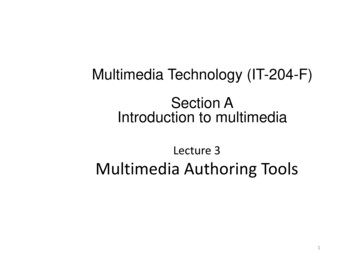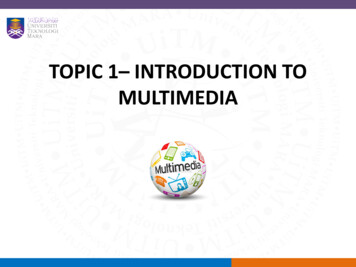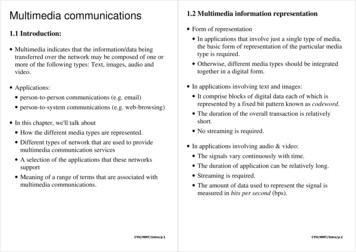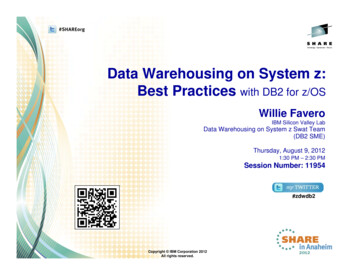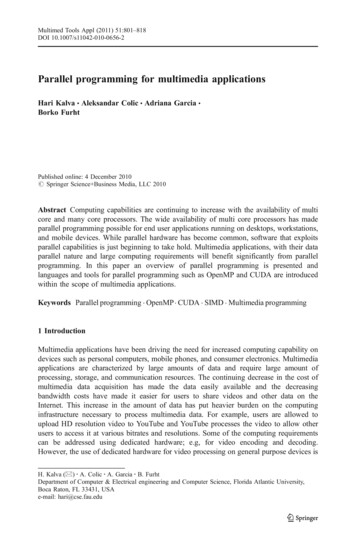
Transcription
Multimed Tools Appl (2011) 51:801–818DOI 10.1007/s11042-010-0656-2Parallel programming for multimedia applicationsHari Kalva & Aleksandar Colic & Adriana Garcia &Borko FurhtPublished online: 4 December 2010# Springer Science Business Media, LLC 2010Abstract Computing capabilities are continuing to increase with the availability of multicore and many core processors. The wide availability of multi core processors has madeparallel programming possible for end user applications running on desktops, workstations,and mobile devices. While parallel hardware has become common, software that exploitsparallel capabilities is just beginning to take hold. Multimedia applications, with their dataparallel nature and large computing requirements will benefit significantly from parallelprogramming. In this paper an overview of parallel programming is presented andlanguages and tools for parallel programming such as OpenMP and CUDA are introducedwithin the scope of multimedia applications.Keywords Parallel programming . OpenMP . CUDA . SIMD . Multimedia programming1 IntroductionMultimedia applications have been driving the need for increased computing capability ondevices such as personal computers, mobile phones, and consumer electronics. Multimediaapplications are characterized by large amounts of data and require large amount ofprocessing, storage, and communication resources. The continuing decrease in the cost ofmultimedia data acquisition has made the data easily available and the decreasingbandwidth costs have made it easier for users to share videos and other data on theInternet. This increase in the amount of data has put heavier burden on the computinginfrastructure necessary to process multimedia data. For example, users are allowed toupload HD resolution video to YouTube and YouTube processes the video to allow otherusers to access it at various bitrates and resolutions. Some of the computing requirementscan be addressed using dedicated hardware; e.g, for video encoding and decoding.However, the use of dedicated hardware for video processing on general purpose devices isH. Kalva (*) : A. Colic : A. Garcia : B. FurhtDepartment of Computer & Electrical engineering and Computer Science, Florida Atlantic University,Boca Raton, FL 33431, USAe-mail: hari@cse.fau.edu
802Multimed Tools Appl (2011) 51:801–818not a cost effective solution. Innovations in algorithms, software, and tools have madepossible the use of general purpose processors for high performance multimediaapplications. Of all the methods to develop high performance multimedia applications,parallel programming stands out because of the performance gains it promises. As the nameimplies, parallel programming involves executing portions of a problem in parallel in orderto reduce the overall execution time. Multimedia applications exhibit parallelism and canbenefit tremendously from such an implementation.While computing capabilities have increased greatly, especially with the recentavailability of quad-core CPUs and many core GPUs that support parallel programming,effective use of these capabilities seems to have trailed. The use of parallel executioncapabilities on these processors requires the utilization of proper programming and softwaredevelopment techniques. This leads to one of the challenges in bridging the gap betweenparallel processing capabilities of the hardware and the end user applications: the lack ofsoftware that exploits the hardware as most programmers are trained in and the use ofsequential programming [1]. With many-core processors with hundreds of cores on thehorizon [2], there is an urgent need for jump starting the use of parallel programming inhigh performance applications. Another trend that has emerged over the last 4 years is theuse of graphics processors (GPU) for general purpose programming [20]. GPUs presentanother alternative for parallel implementation of multimedia applications and areespecially suitable for highly data parallel problems. Multimedia applications, with a needfor large amount of computing resources, and data that lends itself to parallel processing,are the first to benefit form these new developments in parallel programming.Figure 1 shows the parallel programming hierarchy—parallel programming andprocessing possible at different levels in a computing environment. At the lowest level isthe instruction level parallelism supported by Single Instruction Multiple Data (SIMD)instruction sets available on most processors today. These instructions can be used tospeedup data parallel computations. Each core of multi-core processors supports SIMDinstructions and optimizations at this level require thorough knowledge of instruction setsand assembly programming. SIMD instruction set programming is usually used toaccelerate code segments or sub components of larger programs.Multi-core processors and shared memory multiprocessor systems can speed upapplications when using multiple threads and/or multiple processes. At this level, parallelprograms can be written using multi threaded programming using explicit threadingsupported by the operating system or using programming frameworks such as OpenMP.Multithreaded programming at this level is independent of SIMD programming and bothcan be used to speedup program execution. At the highest level of hierarchy is cloud orcluster computing where multiple systems connected over networks are used to solve largescale problems or process large amounts of data. In distributed programming, data is spreadamong the available systems in a cluster/cloud and processes executed on each systemcomputes the data assigned to it. The processes executing on each node can be optimizedusing multithreaded and SIMD instruction set programming. Effective implementation canthus exploit parallel processing capabilities at all levels of execution there by maximizingthe speedup.In this paper each of the four approaches described above are discussed emphasizingtheir usage in the multimedia area. Specifically, Section 2 discusses the multimediacapabilities on General Purpose Processors and current multimedia instruction sets.Section 3 overviews parallelism in multimedia applications highlighting the parallelism inthe area of video encoding in particular; finally Section 4 discusses programming languagesand tools for parallel programming, specifically OpenMP and CUDA and briefly overviews
Multimed Tools Appl (2011) 51:801–818803CLOUD/CLUSTERLarge scaleprocessing g OCESSORPROCESSORHigh performanceuser applicationsMultithreadedProgramming (E.g.,OpenMP/C )PROCESSORCORECORECORECORESIMD INSTRUCTIONSEXECUTION UNITSHYPERTHREADINGHigh performanceuser applicationsMultithreadedProgramming (E.g.,OpenMP, OpenCL, CUDA)Subcomponents, andcode segmentsSIMD InstructionProgramming(E.g., Assembly, C intrinsics)Fig. 1 Hierarchy in Parallel Programmingthe subject of cloud computing for multimedia applications with a particular emphasis onthe Hadoop platform, whose free and open nature make it worth exploring.2 Multimedia capabilities on general purpose processorsAs computing needs driven by multimedia applications grew, processors with increasinglymore capabilities were developed. In the 90s, the emphasis was on packing moretransistors, increasing the operating frequency, and adding dedicated instructions to increasethe processing capabilities. With the realization that the operating frequencies cannotcontinue to increase, the industry focus has shifted to the use of multiple cores on the same
804Multimed Tools Appl (2011) 51:801–818processors. This trend is expected to grow and processors with hundreds of cores are on thehorizon. However, software parallelization is a complex task and converting all the existingsoftware to exploit parallel hardware is unlikely to happen. Multimedia applications are thekind of applications that can benefit from parallel implementations and given theirsignificance and wide use, are expected to drive the demand for multicore processors andparallel implementations.2.1 Multimedia instruction setsThe multimedia extensions to general purpose processors were primarily driven by theadvent of digital video, 3D graphics, and gaming applications. The need for increasedperformance on PCs and the data parallel nature of the target applications resulted inprocessors with Single Instruction Multiple Data (SIMD) instruction sets. The MAXextensions to the HP PA-RISC architecture were one the first SIMD extensions to generalpurpose processors [17]. The Visual Instruction Set supported on the Sun UltraSparcprocessors provides the SIMD extensions to support multimedia and data parallelapplications [25]. The MMX instruction set for the Intel Pentium processors [23], the3DNow! extensions for the AMD K6 processors, and the AltiVec extensions for theMotorola/IBM PowerPC processor [11] all provided SIMD instructions to speedup dataparallel applications. The SIMD instructions have become common and are used even inembedded processors as a way of supporting parallelism at instruction level.The SIMD instruction set typically consists of parallel arithmetic, logical, comparison,and data movement instructions. Some instruction sets provide type conversion andapplication specific instructions. A comparison of the SIMD support on general purposeprocessors can be found in [12]. Development of high-performance application for suchprocessors has traditionally been done using the assembly language programming or aprogramming library provided by the processor vendor. Both of these approaches render thedeveloped code incompatible for porting to other processors. The lack of software supportis the primary reason for problems in developing applications that harness the full potentialof SIMD instruction sets. The difficulties in developing applications that exploit SIMDinstruction is well discussed in [9].There have been few efforts in developing compilers that exploit SIMD parallelism [16].Compilers that generate optimized code that takes advantage of the SIMD capabilities arebecoming available but are limited by their performance. For example, Intel C compilerperforms some optimization by parallelizing identifiable loops but cannot generate efficientcode in all cases. This also is limited to generating code for Intel processors. Developing acompiler that can understand the parallelism inherent in an application is a very difficulttask. In addition to this, a generic compiler cannot produce optimal code in all situations.An ANSI C extension to support multimedia extensions on general purpose processors ispresented in [3]. Leupers’ work on code generation for multimedia processors addressessome of the issues in optimized code generation for SIMD capable processors [19]. Whilethese techniques may be applied to develop compilers that parallelize code such as the IntelC compiler, they have the disadvantage of being a generic solution for all applications.While the past research addresses the issue of exploiting SIMD parallelism to certain extent,it fails to provide ways to shield application developers from having to master multipleprocessor instruction sets in order to maximize performance.In fact, application developers have traditionally relied on hand-coded assembly levelprogramming in order to achieve high performance. This is the case due to the difficulty ofcreating a generic compiler that can optimize the performance for all applications and
Multimed Tools Appl (2011) 51:801–818805architectures. This creates a scenario where applications are developed for a specific targetprocessor, however, such applications cannot be ported to different processor platforms in away that maximizes the performance on that platform as well. To achieve comparableperformance, the applications have to be re-written using the assembly language of thetarget processors. One alternative to this lower level code development is the use oflibraries that implement optimized primitives for particular problem domains (e.g,.optimized libraries for image processing, cryptography).Development of optimized code using a SIMD instructions set is time consuming andhigher level programming alternatives may be appropriate. Since SIMD instruction sets areorthogonal to multi-core capabilities, one may achieve the desired performance goals byusing parallel programming on multi-core processors and leave instruction level parallelismto the compiler.3 Parallelism in multimedia applicationsTwo processes can be executed in parallel when results of one process do not depend onand do not affect the second process. Parallelism can be broadly classified into dataparallelism and task parallelism. Multimedia applications exhibit both types of parallelism.In data parallel problems, data can be processed in parallel by multiple processors. Forexample, encoding individual frames of video sequence as Intra frames or JPEG frames canbe performed in parallel as there are no dependencies between processes encoding twoseparate frames. Figure 2 shows two ways of partitioning data among the availableprocessors. The data partitioning decisions depend on the application needs. If theapplication needs each frame to be processed as fast as possible, the partitioning shown in2.b would be appropriate. On the other hand, if the application needs to maximize the totalnumber of frames processed in a given time, the partitioning shown in 2.a is moreappropriate.When the frames of a sequence are coded using predictive coding, they cannot beencoded in parallel because the current frame depends on the previous frame. In such cases,an encoding task can be broken down into sub-tasks that are performed in a sequence andthis sequence of tasks can use pipelining to execute in parallel. Alternatively, data parallelsub-tasks can be identified and executed in parallel. When performing motion estimationnon-overlapping blocks in a video frame can be processed in parallel. In task parallelproblems, different tasks can be executed in parallel. For example, in video encoding, while oneprocessor is encoding frame n, a second processor can perform pre-processing on frame n 1.Consider an example where each frame of video has to go through a set of tasks A, B, C,and D respectively. The problem is task parallel if the tasks A, B, C, and D can be executedin parallel. If there are dependencies between the tasks, they cannot be executed in paralleland alternative strategies such as pipelining can be used (Fig. 3). Tasks can be pipelinedFig. 2 Example of a data )5CPU36
806Multimed Tools Appl (2011) 51:801–818Fig. 3 Use of pipelining toparallelize dependent tasksTask ATask BTask DTask CT1Frame 1T2Frame 2Frame 1T3Frame 3Frame 2Frame 1T4Frame 4Frame 3Frame 2Frame 1CPU 1CPU 2CPU 3CPU 4such that CPU1 performs task A on a given frame and the output of task A is used by CPU2to perform task B. Even though there are dependencies that prevent parallel execution (taskB cannot be executed before task A), pipelining can be used to execute A and B in parallelbut on different data sets. With pipelining, CPU1 runs Task-A on Frame 1 and CPU2 waitsuntil CPU1 is finished with Task-A on Frame 1. At this time CPU 1is free to run Task A onFrame 2 and CPU 2 can run Task B on Frame 1 in parallel. This continues until all the tasksand/or CPUs are executing in parallel.3.1 Parallelism in video encodingVideo encoding is a computationally intensive process and exhibits data parallelism. Thedata parallelism varies with the type of the encoders used. All practical video encoderstoday are based on hybrid video coding techniques—compressing video with a hybrid ofmotion compensation and transform coding. Video encoders reduce the redundanciesamong the frames of a video sequence using predictive coding techniques. Since predictivecoding techniques use previously coded data to form predictions, this introducesdependencies that reduce data parallelism.; frames of a video cannot be encoded in parallelbecause of inter-frame dependencies. However, independent operations such as preprocessing on video frames could be performed in parallel. A video frame is typically encoded asmacro blocks (16 16 pixel blocks) and coding of pixels in a block could depend on codingof pixels of previously coded blocks. Figure 4 shows a typical encoder and amount ofdependencies and parallelism in the process. Some video encoders offer opportunities toparallelize the encoding process by allowing the encoding process to encode a set of blocks,referred to as a slice, independent of other slices.The performance of parallel processing is measured using a metric known asspeedup; speedup is defined as the ratio of time taken to execute a parallel program and1001010100111Color pendencies Increase – Data Parallelism DecreasesFig. 4 Parallelism in video encoding
Multimed Tools Appl (2011) 51:801–818807the time taken by a best sequential implementation to accomplish the same task. Anysequential processing required in an application reduces the overall speedup. Theamount of parallelism and hence the speedup that can be achieved depends on theparticular problem.To maximize the speedup for a parallel implementation, the sequential portions of thecode must be reduced. The extent to which problems can be parallelized depend on thenature of the problem. The MPEG AVC/H.264 video encoder is an interesting problem tostudy the trade offs in parallel encoding. The MPEG AVC/H.264 video encoders compressa video frame as one or more slices [18]. A video frame is comprised of a fixed number ofmacro blocks (16 16 non-overlapping blocks) and a slice is a set of macro blocks. A slicecan be encoded independent of the other slices in the frame. Macro blocks use data fromother coded macro blocks in the slice to improve compression efficiency (i.e,. reducesbitrate for the same quality). As the number of slices increases, parallelism increasesbecause the slices can be encoded independent of each other. However, the compressionefficiency suffers because of increased slice overhead and also because the macro blocks ofa slice have fewer neighboring MBs to depend upon. This presents an interesting problemof trading off compression performance for parallelism and encoding speed that isillustrated here via experimentation.Using the x264 video encoder Experiments were conducted to study such tradeoff.Video sequences at 352 288 resolution and 30 frames per second were encoded with 1 to64 slices and at bitrates from 200 to 1000 Kbps. The quality of video was measured usingpeak signal to noise ratio (PSNR). Figure 5 shows a plot of PSNR, a measure of videoquality, and the bitrate of the compressed video with the video encoded using differentnumber of slices per frame. As the number of slices increase, dependencies decrease, andcompression performance (quality for a given bitrate) decreases. On the other hand,parallelism increases because slices of a frame can be encoded in parallel. On a four coremachine used for these experiments the increased parallelism resulted in a speed up of 2.65for video coded with four slices. Servers with eight processing cores are fairly common andencoding the video with eight slices will further improve the speedup. However, with eightslices, the quality of the video drops by about 1 dB compared with single slice encoding.The video quality achieved with 8 slices encoded at 500 Kbps can be achieved by a singleFig. 5 RD performance curveRD Performance for Football Sequence37PSNR (dB)3533311 Slice4 Slices8 Slices16 Slices32 Slices64 Slices292725175375575Bitrate (Kbps)775975
808Multimed Tools Appl (2011) 51:801–818slice video encoder at about 400 Kbps. The cost of the increasing the parallelism is increasein bitrate of 100 Kbps or a decrease in quality of 1 dB.4 Languages and tools for parallel programmingThe languages and tools used to write parallel programs depend on the underlying thehardware and the programming model supported by the hardware. The available tools arestill limited and continue to evolve into simpler tools and languages. The performance gainsdepend on the problem, the amount of effort in tuning the software, and the underlyinghardware. Programmers have to consider their application requirements and performancetargets when selecting a parallel programming framework. A sophisticated vectorizingcompiler may be able to generate code with parallel instructions and provide the desiredperformance without explicitly parallelizing the coder. As with any software optimizationefforts, developers should check for correctness and performance after every parallelizationstep.The following sections present most commonly used tools for parallel programming,focused on programming applicable to common class of multimedia applications—applications used by end users and run on desktops or individual workstations. We alsodiscuss the use of Hadoop for large scale problems using distributed programming.4.1 OpenMPOpenMP is an API to write parallel programs in C/C and Fortran for shared memoryprocessors [5]. OpenMP began as an industry driven effort to provide a standardizedparallel programming framework for shared memory multi-processor systems. Sharedmemory processors have a common memory that is shared by all the computing cores ofthe processor. All the multi-core processors that are being used today fall in this categoryand are suitable for developing parallel programs using OpenMP. In addition, most of thecurrent C/C compilers support OpenMPOpenMP programmers use extensions to C/C and Fortran—compiler directives, aruntime library, and environment variables in developing parallel applications. The compactnature of the OpenMP framework and the ability to parallelize the code incrementallymakes parallel programming with OpenMP easier. Programmers describe parallelism at ahigher level and the OpenMP compiler handles the creation and management of threadsnecessary for parallel execution on the underlying hardware. OpenMP offers incrementalparallelism; i.e, only portions of a sequential program can be parallelized allowing for quickperformance gains on multi-core processors.OpenMP is based on a fork-join model of parallelization where a master thread forksmultiple worker threads to execute in parallel. The worker threads join and synchronize atthe end of the parallel section and the sequential execution continues.Consider the problem of motion estimation in video compression. A prediction iscomputed for every macro block (MB)—a 16 16 block of pixels—in a frame and thedifference between the current and the prediction is then compressed. The prediction for agiven block is determined by searching a reference frame—a previously encoded frame,and finding a block that is closest to the current block in a given search range. Motionestimation represents the most complex stage of video compression and can account for asmuch as 80% of the encoding time. Figure 6 shows a full search motion estimationalgorithm implemented in C for sequential execution. The motion estimation is performed
Multimed Tools Appl (2011) 51:801–818809char **pCur; // current frame bufferchar **pRef; // reference frame bufferint nWidth; // width of the frameint nHeight; // height of the frameint nRange; // motion search range// iterate over all MBs in a framefor(int y 0; y nHeight; y 16){for(int x 0; x nWidth; x 16){BlockMotionEstimation(pCur, pRef, x, y, nWidth, nHeight,nRange);}}// Full Search Motion EstimationBlockMotionEstimation (unsigned char *pCur, unsigned char *pRef,int x, int y, int nWidth, int nHeight, int nRange){unsigned int nMinSad 0xFFFFFFFF, nSad;int nMinMVX, nMinMVY;int nBlockNumber (nWidth/16)*y/16 x/16;for(int rx x – nRange; rx x nRange; rx ){for(int ry y – nRange; ry y nRange; ry ){for(int i 0; i 16; y ){for(int j 0; j 16; x ){nSad pCur[x i][y j] – pRef[rx i][ry j];}}if(nSad nMinSad){nMinSad nSad;nMinMVX i;nMinMVY j;}}}// motion vector with the best match (smallest cost)g nMVx[nBlockNumber] nMinMVX - x;g nMVy[nBlockNumber] nMinMVY - y;}Fig. 6 Full Search motion estimation computed sequentiallyfor all MBs in a frame. For each MB, a BlockMotionEstimation() function is called toperform motion estimation for the block with in a given search range.Parallelizing this motion estimation loop using OpenMP is very simple and requires onlyone line of code—an OpenMP directive declaring a parallel region (Fig. 7). The “ompparallel for” directive instructs the compiler to distribute the work done in the for-loopimmediately following the directive among all the processors (cores) on the system. In thisexample, if the height of the video is 320 pixels, the outermost for-loop will have 20iterations. On a quad-core processor, each core will execute 5 successive iterations of y inparallel. The OpenMP compiler generates the code necessary to create the threads anddistribute the workload among the threads. To guarantee correctness, programmers mustensure that the successive iterations are independent and can be executed in parallel.
810Multimed Tools Appl (2011) 51:801–818// split the motion estimation task among all// the available cores/processors#pragma omp parallel forfor(int y 0; y nHeight; y 16){for(int x 0; x nWidth; x 16){BlockMotionEstimation(pCur, pRef, x, y, nWidth, nHeight,nRange);}}Fig. 7 Full Search motion estimation computed in parallel using OpenMPOpenMP provides multiple ways to set the number of processors used for parallelexecution: fixed, dynamic, conditional, and run-time decision. By default, OpenMP uses allthe available processors thus making the software independent of the hardware capabilities.The performance of the software will scale when new hardware is released without havingto rewrite the software. As with any parallel programming framework, programmers have totake caution to prevent race conditions. All code before and after this code segment isexecuted sequentially.4.2 SIMD instructionset programmingMost modern processors support SIMD instructions that execute the same operations on anarray of data. These SIMD instructions use large registers to load multiple data elements tooperate on. SIMD instructions support basic operations such as arithmetic, logical, and datamovement operations. For example, a parallel add operation can be used to perform 16additions in parallel using a pair 128 bit registers loaded with 8-bit integers. Since theparallelism is supported at instruction level, programmers need a complete understanding ofinstruction sets and have to write code using assembly programming techniques.The popularity and usefulness of SIMD instruction sets in multimedia programminghave resulted in extensions with instructions specifically targeting multimedia applications.For example, video compression algorithms compute the sum of absolute difference ofpixels often and a dedicated instruction, PSADBW, was introduced in Intel processors. Newcompilers support SIMD parallelism by generating parallel instructions for clearly definedloops and parallel structures. However, hand coding is necessary to optimize reasonablycomplex code segments. Compilers make SIMD programming simpler by providing a Clike API for the SIMD instruction set. These C-functions, referred to as intrinsics, aredefined for each SIMD instruction and guaranty that that particular instruction will be usedin the assembly. Programming with intrinsics relieves the programmer of registermanagement but the programmers still need instruction level knowledge and expertise.SIMD instructions can be used to speedup code segments that exhibit data parallelismand are independent of multi-threaded and multi-core programming. Figure 8 shows the useof SIMD intrinsics to accelerate the computation of motion estimation shown in Fig. 6. TheSIMD implementation loads 16 pixels from the source and destination and computes thesum of absolute differences of 16 pixels in parallel.4.3 GPU programming with CUDAIn the quest for maximum speed, GPUs (Graphics Processing Units) have evolved farbeyond single processors. Modern GPUs are not single processors but rather are parallel
Multimed Tools Appl (2011) 51:801–818811#ifdef USE SIMD OPTasm{//setting starting points for current and reference blockmov ebx,pCurMBData;mov ecx,pRefMBData;mov eax,blockArea;}mm xor si128(xmm2,xmm2);L1:mm store si128 ([ebx],xmm0);//loading current 16 valuesfrom current blockmm store si128 ([ecx],xmm1);//loading current 16 valuesfrom reference blockmm sad epu8(xmm0,xmm1);// doing sum of absolutedifferenies for current 16 values of current and reference blockmm add epi64 (xmm2,xmm0);//adding results to theaccumulatorasm{add ebx,0x10;//increment adresses to pick next 16 valuesadd ecx,0x10;sub eax,0x10;//decrementing counterjnz L1;//checking if all values from the blockhave been processed}mm unpackhi epi64 (xmm3,xmm2);//finalizing of calculationmm unpackhi epi64 (xmm2,xmm4);mm srli si128 (xmm3,8);mm add epi64 (xmm2,xmm3);//sadValue for current block isstored in xmm2mm xor si128(xmm3,xmm3);//cleanupmm xor si128(xmm1,xmm1);//cleanupsadValue mm cvtsi128 si32(xmm2);}#elsefor(int i 0; i 16; y ){for(int j 0; j 16; x ){nSad pCur[x i][y j] – pRef[rx i][ry j];}}#endifFig. 8 Optimizing motion estimation using SIMD programmingsupercomputers on a chip that consist of many fast processors. The large amount ofcompute resources on GPUs make them a good candidate for high performance computing.NVIDIA has put a lot of emphasis on making general purpose programming on GPUssimpler by abstracting the GPU with threaded programming model. NVIDA’s toolkit forGPU programming, called CUDA—Computer Unified Device Architecture—allowsapplications developers to write code that can be run on NVIDIA's massively parallelGPUs [15]. This allows app
using parallel programming on multi-core processors and leave instruction level parallelism to the compiler. 3 Parallelism in multimedia applications Two processes can be executed in parallel when results of one process do not depend on and do not affect the second process. Parallelism can be broadly classified into data parallelism and task .

